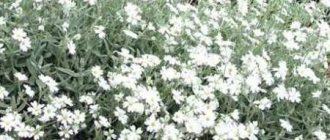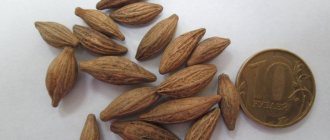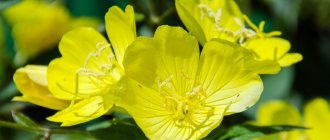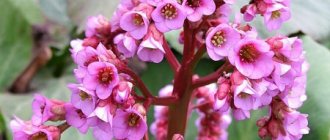Features and description of the flower
Callas are perennial herbaceous plants from the Araceae family. Wild forms prefer marshy soils, can grow half submerged in water, and are distributed throughout the world. Calla has several names: calla grass, marsh grass, serpentine. Mainly African varieties are cultivated. Callas are grown for cutting for bouquets and compositions, as an indoor flower, and used in landscape (street) design.
All parts of the plant are poisonous when fresh. Callas are an unpretentious, shade-tolerant plant. Can grow on sandy, loamy soils with an acidic or neutral acidity level.
The shoots of the plant are creeping or erect, with a height (depending on the variety) of 25-150 centimeters. In some species the rhizome is creeping, in others it has the shape of a tuber. The leaves are large, heart-shaped, with a pointed tip, petiolate, basal, smooth, shiny. They can be green, plain or have white speckles on the surface.
The flowers are located on long bare petioles and consist of a yellowish spadix and spathe. The spadix is located inside, and outside it is surrounded by a funnel-shaped, bright and large bract-veil, which can be snow-white, yellow, scarlet, purple, pink, or orange.
The spadix itself is covered with tiny flowers. Callas bloom in summer. Pollinated by insects. The fruits are small, pomegranate-colored berries with seeds inside, and ripen a month after flowering (late August or September). Callas reproduce by seeds or tubers (dividing the rhizome).
Technology for planting calla lilies in open ground
- The best time to plant calla lilies in open ground is spring, and more specifically the beginning of May. It is at this time that the threat of the last frost, which can harm the plant, has passed.
- In the selected area you need to dig small planting holes, the size of which should be 5-10 cm in depth.
- If you are planting plant tubers in open ground, they must first be stratified and treated with a growth stimulator.
- When planting calla lily seedlings in open ground, it is also advisable to harden them within a week.
- A little drainage can be placed at the bottom of the planting holes to prevent water from stagnating at the roots. Small stones can be used as drainage.
- Calla tubers should be planted with the tubercle facing up.
- When planting ready-made seedlings, they must be carefully removed from the pots, being careful not to damage the roots. After all, the root system of calla lilies is very fragile.
- If you plant several plants nearby, the distance between them should be approximately 30-40 cm.
- You can use mineral fertilizers, approximately 30 grams per square meter. In this case, there is no need to feed the plant throughout the entire growth period.
- Next, planting material is placed in the planting holes and sprinkled with soil. There is no need to heavily compact the soil.
- Planted tubers need to be watered only after the first leaves appear, and seedlings can be watered immediately after planting.

Plant classification
Callas vary in height (from 25 to 155 centimeters), the structure of the root system (with rhizomes or tubers) and the color of the bract-veil.
By type of garden flowers
Callas differ in the type and color of the bract-spread surrounding the yellow spadix. It should be remembered that in all varieties, without exception, the color of the spathe turns green after pollination. The original color disappears.
Ethiopian
It is grown as an indoor and garden crop. Originally from South Africa. This is a rhizomatous plant with a snow-white bract-veil and a yellow spadix. The leaves are wide, heart-shaped, dense. The cover is funnel-shaped, widens at the top, and has a short-tubular shape at the base. The height of the plant sometimes reaches 155 centimeters. Used to create bouquets and landscape decoration. Popular varieties: Golden Goddess, Childsiana.
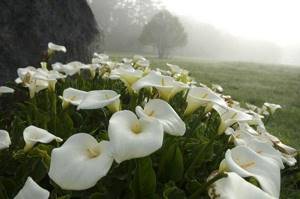
Elliott
A plant with yellow inflorescences and large, smooth, heart-shaped leaves. Propagated by tubers. The height of calla lilies is 50 centimeters. The leaves are wide, greenish with white specks. The cover is long, yellowish-green on the outside, yellow on the inside. Popular varieties: Selina, Black-eyed beauty.
Remani
Low crop (up to 50 centimeters in length) with pink flowers. Propagated by tubers. It has green leaves with white speckles. Spends the winter in hibernation. In autumn it drops all its leaves. Famous varieties: Bolero, Little Susie.
Rhizomatous (swamp)
A low plant (25 centimeters) growing in marshy areas. It has a thick, greenish, creeping rhizome located on the surface of the ground. The leaves are heart-shaped, pointed at the top. The cylindrical cob is surrounded by a snow-white inside, flat, ovoid blanket. Used in landscape design to decorate artificial ponds.
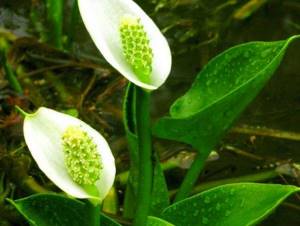
By color variety
Based on the color of the bract, callas are divided into white and colored. The white ones are descended from the Ethiopian variety. They are taller (up to 150 centimeters long), have a long rhizome, love moist soil, and prefer to grow in partial shade.
The ancestors of colorful plants are the pink calla lilies of Remani and the golden-yellow calla lilies of Elliott. The height of such flowers rarely exceeds 50 centimeters; they grow from a tuber. Plants are less demanding on soil moisture, but need good lighting.
Black
A rare variety of callas with a dark burgundy or dark purple bract. The plant grows up to 0.4-1 meters in height, has long, pointed, greenish leaves with speckles. Propagated by tubers and seeds. Famous varieties: Black Crusader, Black Star, Captain Palermo.
Reds
Elegant flowers with a rich red or slightly scarlet cover. Height - 0.4-1 meter. The leaves are heart-shaped, greenish, with white speckles. Refers to tuberous plants. Popular varieties: Majestic Red, Red Sox, Sanglow.
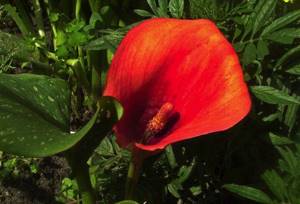
Yellow
Beautiful flowers with a soft lemon or rich tangerine cover. Plant height is 0.5-1 meter. The leaves are heart-shaped, shiny, greenish, pointed. Propagated by seeds and tubers. Known hybrids: Captain Amigo, Captain Cupid, Yellow Giant.
Purple
Graceful purple or lilac flowers with a wide cover wrapped in a narrow tube and at the top. The leaves are pointed, arrow-shaped, green, speckled. Tuber culture. Famous hybrids: Amethyst, Picasso, Ash Hayes.
Pink
Pink flowers hybridized from wild African species. Stem height is 30-90 centimeters. The leaves are oblong, green, growing from below. Propagated by seeds and tubers. Famous varieties: Zantedeschia white-spotted, Ethiopian, Zantedeschia Elliott, Remannia and others.
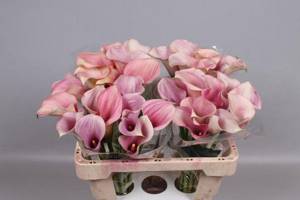
Burgundy
The plant is 0.4-0.9 meters high with a burgundy-colored cover. The leaves are green, speckled, heart-shaped. Tuber culture. Popular varieties: Schwarzwalder, Majestic Red.
White
Snow-white flowers symbolizing purity. Plant height is 50-150 centimeters. It has long, greenish, heart-shaped leaves. Famous varieties: Ethiopian childziana, Hazmanta Ethiopian, Hercules, Cameo.
Orange
Beautiful flowers with an orange blanket. Height - 30-70 centimeters. The leaves are oblong, green, speckled. Tuber culture. Popular varieties: Mango, San Remo.
Blue
Flowers symbolizing calm and nobility. The bract-bract has a soft blue or deep blue color. The leaves are oblong, heart-shaped, greenish. Famous varieties: Ice blue, Teal blue, Merlin blue.
See also
Description and characteristics of types of perennial flowers for the Urals, planting and careRead
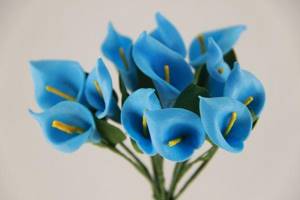
The best varieties for planting
Callas are divided into tuberous (Remani, Elliott) and rhizomatous (Ethiopian). Based on these varieties, a huge number of varieties have been bred. Derived from the Ethiopian variety, the cultivars have white inflorescences and tall stems. Tuberous callas (Remani, Elliott) gave rise to low-growing, multi-colored varieties.
Cantor
Exquisite dark purple, waxy flowers. The height of the crop rarely exceeds 60 centimeters. The leaves are greenish, with white dashes. Flowering - from July to September.
Mix
Culture 40-60 centimeters high. It has inflorescences of various shades. The leaves are vertical, spear-shaped. Blooms for one month. It reproduces most often by tubers.
The Snow Queen
This is a garden calla with snow-white, almost transparent leaves with greenish edges. The flowers stand out effectively against the background of white foliage, the bracts of the calla lilies are a rich pink hue.
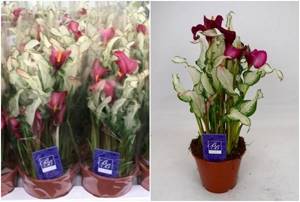
Chameleon
A delicate plant with cream, slightly pinkish and yellowish flowers. Forms a lush rosette of wide, greenish leaves with white speckles. The height of the crop is no more than 65 centimeters.
Casper
A low plant with a lush rosette of green, arrow-like leaves and bluish peduncles. It reproduces most often by tubers. Blooms from July to August.
Mozart
A plant with a lush rosette of dark green, white speckled, wide leaves and peduncles with bright orange, slightly reddish flowers. The height of the crop is about 75 centimeters.
Remani
This variety has beautiful pink flowers. The leaves are wedge-shaped, greenish, growing from the base of the stem.
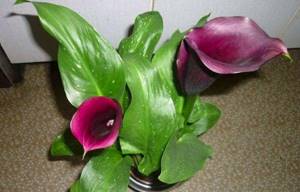
Black Star
It is distinguished by an interesting inflorescence of a dark burgundy hue. The leaves are narrow, spear-like. The height of calla lilies is 60-70 centimeters. Blooms all summer long.
Captain Promise
A showy plant with dark purple flowers. Grows up to 55-65 centimeters. The leaves are large, dark green, with rare light splashes. Blooms throughout the summer.
Remanna
A lush plant with pink flowers and greenish, oblong leaves. Reaches a height of 40-70 centimeters.
Gold medal
A beautiful, low plant with graceful rich yellow flowers. The leaves are oblong and arrow-shaped. Blooms from July to August.
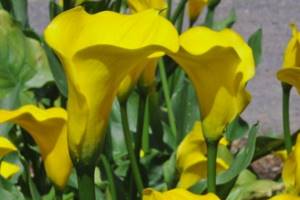
Rudolf
A dark burgundy, funnel-shaped flower on a long stem. The plant forms a lush rosette of large greenish, speckled leaves and several flower stalks. Height - 50 centimeters.
Mango
A low plant with a lush rosette of large, dark green leaves with small light specks. Flowers are deep orange. Blooms from July to August.
Garnet glow
A beautiful flower 60 centimeters high with a lush rosette of green, large, oblong leaves. In early June, pale pink inflorescences appear. Calla blooms for almost 3 months.
Paco
An exotic-looking plant with soft purple flowers. The leaves are oblong, dark green, and resemble arrowheads. It blooms for 1.5 months, from July to September.
The most popular types and varieties of calla lilies
All callas can be divided into rhizomatous and tuberous. All hybrid plant species, such as Ethiopian calla, can be classified as rhizomatous. Calla lilies include Rehmann and Eliott calla lilies. All of them are grouped into these two categories based on the structure of the root system.
There is also another division of these plants into groups. In total, there are eight species of this herbaceous perennial in nature. However, the most popular are Ethiopian calla, Remann's calla, Eliot's calla, white-spotted calla, swamp calla and others. Let's take a closer look at the most popular and common types and varieties of calla lilies.
Calla Ethiopian
- It is a tall plant that can reach 100 cm or more.
- This type of plant is distinguished by snow-white flowers.
- Ethiopian calla lilies are rhizomatous plants whose roots are located underground. These flowers do not have bulbs.
- The leaves and peduncles of this type of calla lily are preserved even during the dormant period of the plant.
- A very moisture-loving plant that prefers to grow in the shade, along the banks of rivers, lakes and reservoirs.
- The best period for active growth and flowering is from May to September.
Popular varieties of Ethiopian calla lilies:
- Variety "Nicolai". A very tall herbaceous plant that can reach a height of 150 cm. Leaves on long petioles and peduncles are of the same length. The leaves are arrow-shaped, mounted on long petioles, with a shiny and smooth dark green surface. The outside cover is green in diameter and reaches 12 cm in diameter.
- Variety "Pearl". It is a low-growing variety of calla lily plant. It can reach only 50 cm in height. This type of plant can be easily grown in open ground in pots.
- Variety "Schone Zweibrückerin". A medium-sized variety of calla lilies, which can grow up to 1 m in height. The leaves are quite large and heart-shaped. The blanket is white, has a greenish tint underneath, and reaches 15 cm in diameter.
- Variety "Green Goddess". Also a medium-sized variety that can grow up to 90 cm in height. It is distinguished by bright green flowers.

Calla Remanna
- This type of calla lily is characterized by its short stature. The maximum plant can grow is 70 cm.
- The underground part of this flower is the tuber.
- The leaves are oblong, dark green, and can reach 30 cm in length.
- The bedspread features a vibrant reddish pink or reddish burgundy bedspread.
- A plant of this species sheds its leaves during the dormant period. This usually occurs in winter, and in spring the calla lilies appear with new leaves and flower stalks.
- Prefers to grow in dry areas.
Popular varieties of calla lilies Rehmann:
- Variety "Chameleon". This is a low-growing variety of calla lilies that can be grown without problems both in pots and in open ground. The bedspread is distinguished by its beautiful colors: delicate peach color with golden hues.
- Variety "Evening". This calla lily is distinguished by a rather extravagant coloring of the bedspread: a rich black-lilac shade. The surface of the petal itself is satin.
- Variety "Indian Summer". The cover of this calla variety has a reddish-garnet hue.

Calla Elliott
- A low-growing type of calla lily that can grow up to 50 cm.
- The underground part of the plant is a tuber.
- The leaves of Calla Elliott are quite large, heart-shaped, dark green with white speckles.
- The leaves are attached to long petioles.
- The color of the bedspread is yellow on the inside and yellowish-green on the outside. It can reach 15 cm in diameter.
- Prefers to grow in open sunny places with the possibility of partial shade during the hottest periods of the day.
Popular varieties of Elliot's calla lilies:
- Variety "Yellow Corner". This variety of calla lilies is distinguished by bright yellow flowers and large green leaves with yellow speckles.
- Variety "Black-eyed beauty". The outer part of the bedspread has a delicate cream color with a slight lemon tint, the leaves are large and spotted.

In addition to the above types of calla lilies, one can note the white-spotted calla lily, the joyful calla lily, and the powerful calla lily. However, in Russia and other CIS countries, these types of calla lilies are rarely grown.
Conditions necessary for the growth and flowering of the crop
Garden callas grow only in spring and summer, and in the fall, before winter, the tubers or rhizomes of the plant are dug out of the ground. This heat-loving crop can be pre-planted as seedlings and transferred to the flowerbed only at the end of May. During the same period, calla lily tubers are usually buried in open ground.
Lighting
Callas need to be provided with good lighting; in the shade they will grow and develop poorly. The plant easily tolerates partial shade. In the summer midday heat, the leaves need to be covered from the scorching sun. In too sunny areas, as well as in the shade, callas may not bloom.
Temperature
In spring and summer, the optimal temperature for callas is 15-25 degrees Celsius. Plants are transferred to the flowerbed only at the end of May, when the air has warmed up well and the threat of night frosts has passed.
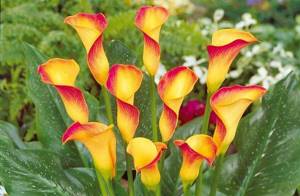
Required soil composition
Callas prefer fertilized, loose, slightly acidic or neutral soil. They react negatively to fresh manure. They can grow on loams previously diluted with peat and sand. For calla lilies, garden, turf, leaf soil with the addition of sand and peat is suitable.
Humidity
In summer, callas need to be provided with abundant watering. In hot weather, it is advisable to spray the leaves with cold water (in the evening). Air humidity should be 60 percent or higher. True, the plant does not tolerate too swampy soil.
Rules for choosing planting material

Kalla Rehmanni
The first thing to do is to choose a variety of calla lilies that will show off on the site. This is not a very difficult question, since special stores offer customers a lot of varieties of this plant for every taste, and you will certainly choose the best plant for your site. The most popular varieties of calla lilies are Rehmanni and Ethiopian. Most garden plants originated from Ethiopian varieties.
Caring for callas in the open ground is not an easy task, requiring compliance with all necessary conditions. The fact is that the African beauty needs special care that will bring it closer to natural conditions. However, if all the recommendations are followed, a hardworking gardener will be able to grow a flower up to a meter in length, topped with a massive flower with massive leaves.
Rules for choosing a plant
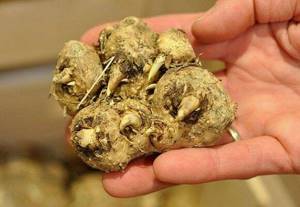
Calla lily tubers
Planting calla lilies in open ground will be successful if the following conditions are met:
1. You can get rid of difficulties in the process of growing plants if you select planting material correctly. The calla tuber must be large in size and free from dents, wrinkles and other defects.
2. In order to be sure of the longevity of the plant, preference should be given to tubers grown in the Russian climate. Of course, you can plant a flower whose tubers developed in natural conditions, but in this case flowering will occur much later, and the result may completely disappoint you.
3. Planting can be done using a branched root system or tubers. In the first case, gardeners use parts of the rhizome, in the second - tubers. You can also use seeds. Based on the desired planting method, you should choose the highest quality rhizome with no external defects.
Growing a plant in the garden
Callas are usually grown from tubers or by dividing rhizomes. High-quality planting material should have a healthy appearance and not be limp or wrinkled.
Disembarkation dates
Tubers or rhizomes can be immediately planted in the flowerbed at the end of May. True, many gardeners prefer to pre-grow seedlings. In this case, the tubers (rhizomes) are planted in separate containers filled with soil in early April. The soil is irrigated with water from time to time. When the sprouts appear, they are provided with ten hours of daylight, a temperature of 20 degrees Celsius and regular watering.
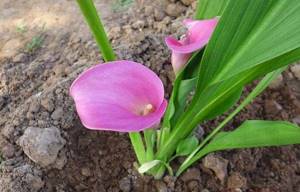
According to the plant variety
Tubers of colored calla lilies of various varieties are planted in a flowerbed in the middle or end of May, when the air warms up to 15 degrees Celsius and the threat of night frosts has passed. You can pre-germinate the tubers in containers with soil, and transfer the grown seedlings to the flowerbed.
White Ethiopian callas are propagated by dividing the rhizomes. In April they are planted in plastic cups with moistened soil. At the beginning of summer, the rhizomes, along with the sprouts, are transplanted into a flower bed.
Depending on the growing region
For Siberia, it is advisable to first grow seedlings and transfer them to a flowerbed in the summer. At the beginning of April, the tubers need to be planted in small containers, for example, in plastic cups. Each root must be planted in a separate pot. For planting, use universal purchased soil for flowering plants.
You need to water the soil 2-3 times a week. Before transplanting to the flower bed, the seedlings are hardened off. They are taken outside for several hours every day. Callas are transplanted using the transshipment method: together with a lump of earth, they are deepened into a previously dug hole.
Selecting planting material and planting site
Planting material must be domestic and correspond to the climatic characteristics of the region. The size of the tuber indicates the age of the plant. The larger it is, the older the culture. A large tuber planted in the ground is guaranteed to bloom and produce several flower stalks. Well-lit places are suitable for planting, however, Ethiopian calla lilies feel great in partial shade.
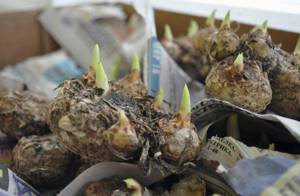
Preparing the garden plot
Before planting, the soil must be dug well, cleared of weeds, and loosened. It is advisable to disinfect the soil with a solution of potassium permanganate or fungicide. A week before planting, the soil can be fertilized with nitrogen, potassium and phosphorus. For 1 square meter of flower beds take 35 grams of ammonium nitrate, superphosphate and potassium sulfate.
Planting tubers in open ground
Tubers are planted in holes dug in the ground to a depth of 5-10 centimeters. The top is sprinkled with earth and irrigated with water. There should be a distance of 30 centimeters to the neighboring plant. It is undesirable to heavily compact the soil above the tuber or rhizome.
See also
Types and varieties of garden yucca, planting and care in open ground, how to cover it for the winterRead
Choosing a place for calligraphy
Calla lilies, both tuberous and rhizomatous, prefer to grow in a well-lit place. At the same time, diffused light is more suitable for it. If you grow it at home, you can place the pot on a window with a western, eastern or southeastern orientation. On southern windows, it is advisable to place the flower next to the window, behind a light tulle curtain, for example.
The rhizomatous calla, which does not shed its leaves in the winter, also requires bright light after flowering. In order to provide it with the required amount of light, lighting sources with a radiation intensity of at least 700 lux are installed next to it. Lamps are also required when the grower wants to force the bulbs to start growing after a short rest.
When grown in the countryside in open ground, it is recommended to plant the plant in well-lit areas with slight shading during the midday hours. Just like indoor form, outdoor form does not tolerate direct sunlight and sudden fluctuations in air temperature. To avoid the occurrence of traumatic factors, it is recommended to choose elevated areas for planting, protected from the north by buildings or other crops.
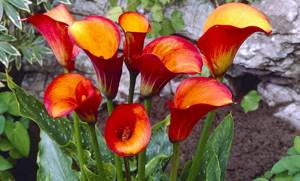
How to properly care for callas
Garden callas need to be cared for regularly: water them in a timely manner and apply fertilizer to the soil. Plants will bloom 4-6 weeks after planting. Pre-grown seedlings will produce flowers as early as June. Garden callas bloom all summer.
Regularity of watering
Callas are watered only during dry seasons, when it has not rained for a long time. Watering is carried out after 2-3 days. Constantly ensure that the soil does not dry out too much. Use soft, settled water, preferably rainwater. You can acidify it a little with vinegar or citric acid. Rhizomatous Ethiopian callas prefer to grow in moist soil. Such plants can be planted in partial shade, on the shore of a pond.
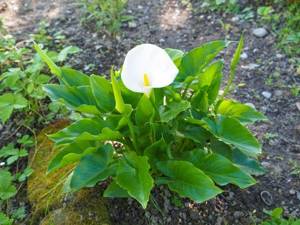
Spraying
In hot weather, calla lily leaves can be irrigated with cold water. True, it is advisable to spray in the evening. You should not irrigate the leaves in the midday heat.
What fertilizers to apply
At the very beginning of growth, the soil is fertilized with nitrogen additives. Before flowering, callas are fed with potassium and phosphorus. You can use complex fertilizers for flowering plants (Good Power). Callas are fed 2 times per season.
Loosening the soil
The soil near the plants needs to be regularly weeded, weeds removed, and loosened. Be sure to break up the soil crust. You can bring earthworms into the flowerbed. They help loosen the soil and enrich it with nutrients.
Calla lily pruning
To stimulate the formation of flower stalks, it is necessary to constantly remove flowers that have already bloomed. After the callas have completely finished flowering, they are watered occasionally, and in the fall, all the greenery is cut off and the roots are dug up.
How to transplant calla lilies
Adult calla lilies purchased in a store should be immediately transplanted into a flower bed. First, moisten the soil in the pot. A place for planting is prepared in the flowerbed, corresponding to the size of the pot. The calla lilies are carefully removed from the container and, together with a lump of earth, transplanted into the garden bed. Then the ground is watered abundantly.

Caring for garden calla lilies
Caring for garden calla lilies is quite simple. This plant develops well in a wide temperature range from 15 to 25ºС, so creating optimal conditions for it in the spring and summer is not difficult. This flower tolerates heat with difficulty and only with abundant watering.
The basis for successfully growing garden callas is timely watering. All species, and especially rhizomatous varieties, do not tolerate drought well. Therefore, you need to water them regularly, making sure that the soil never completely dries out. Typically, tuberous callas are watered twice a week, and rhizomatous callas - 2-3 times a week. When the summer heat sets in, watering must be increased.
Rhizomatous and tuberous callas are watered differently. Rhizomatous varieties are not afraid of excess moisture and do not suffer from root rot. Tuberous colored plants should be watered so that as little water as possible falls on top of the tuber. This will prevent rotting and death of plants. During the entire growing period, they are watered between the rows.

In the area where garden callas are grown, it is necessary to maintain high air humidity. This is usually why they are planted under tree canopies or near a pond. And regular watering helps to provide the necessary conditions for their growth and development. Just don't overwater the plants. Stagnation of water in the soil is just as harmful to them as drying out.
In the process of growing these flowers in the garden, they require regular weeding and loosening of the soil . Weed the area as the weeds grow 3-4 times a month. Loosening the soil is carried out after each watering to ensure air access to the roots of the plants.
Typically, once the soil is fertilized at the time of planting, no further fertilizing is required. Sometimes, if the soil on the site is insufficiently acidic, you can water the plants once a month with water acidified with citric acid (1 pinch per 5 liters of water).
Main problems when growing
During the growing process, gardeners may encounter a number of problems. Callas do not bloom, turn yellow, and dry out if you choose the wrong place for planting, do not fertilize the soil, rarely water the plants and do not pre-treat them with fungicides against possible fungal infections.
Why do the leaves turn yellow and dry?
There are several reasons why calla lilies' leaves may turn yellow and dry out. For example, plants are planted in an area that is too sunny, and the leaves simply fade in the sun. Callas may lack moisture.
Leaves often turn yellow when there is a lack of nutrients in the soil (nitrogen). If a plant is infected with a fungal infection, it begins to ache, and the leaves turn yellow and wither. The cause of yellowing may be parasites.
In order to save callas, they need to be watered regularly, complex fertilizers applied on time, and treated with a fungicide solution (Fitosporin) as a preventive measure against diseases.
Calla does not bloom
Many gardeners face this problem. Callas will not bloom if the soil is richly fertilized with organic matter or nitrogen supplements. In this case, the greenery will begin to grow wildly. Flowers may not appear if the tubers or rhizomes are placed very deep in the ground. Callas need to be watered regularly, but it is not recommended to overfill the flowerbed with water. The area where callas grow should be well lit by the sun. Sometimes flowering may never occur if the variety for a particular region was selected incorrectly.
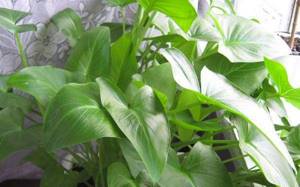
Stages of preparation before planting calla lilies
Planting and caring for calla lilies is not particularly difficult, but to obtain a healthy and beautiful flowering plant, you need to put in a few efforts in preparation for planting. It is important to purchase high-quality and healthy planting material, as well as find an ideal place on your site to plant an exotic beauty.
Stage 2. Selection of planting material
- It is best to purchase planting material from varieties that have been successfully acclimatized to the conditions of your area. To avoid making a mistake with your choice, you can consult specialized stores.
- You can purchase planting material in the form of tubers. In this case, carefully inspect them for damage or signs of disease. Tubers should be strong and elastic, with live apical tubers. Such planting material costs much less than ready-made seedlings.
- In specialized stores and nurseries you can purchase ready-made seedlings in containers, which are immediately planted in open ground.
- Do not purchase calla lily seedlings or tubers from spontaneous markets or from strangers.
- Also remember that the flowers drawn on the labels will be different in real life. You are unlikely to get such a bright and rich color; besides, after pollination, the bedspreads of almost all varieties turn green.
- Select calla lily seedlings based on the planned composition, as these plants differ in leaf height and color of flowers.

Stage 2. Selecting a landing site
Callas naturally grow in the moist soils of tropical forests, so the necessary conditions for the growth of this plant must also be created on the site. The optimal place for calla growth will be an area near small reservoirs, ponds or lakes where soil moisture is high. If you don’t have an artificial pond on your property, you can choose a place in the garden. Make sure that the area is not heavily shaded, otherwise the calla will lose the color of the cover.
The choice of location also depends on the composition you have in mind. These flowers look great next to other flowering plants in flower beds, as well as in single plantings. By planting several calla lily plants together, you can create a carpet of these plants.
Stage 3. Selection and preparation of soil
Callas prefer to grow in fertile and nutritious soils that are well moistened. Keep in mind that in soil with a very high organic matter content, calla lilies may grow slowly. Since this is an exotic plant, calla lilies can take root very slowly in our soils. Therefore, it is best to purchase a special mixture in stores. The best substrate for the growth of calla lilies should consist of turf soil, leaf soil, sand and peat.
Before planting plants, be sure to dig up the selected area well. making it lightweight and breathable.
Flower diseases
Calla lilies can get sick. Most often, plants suffer from a fungal infection. The disease can be triggered by rainy, cool weather, or lack of nutrients in the soil. As a preventative measure, it is recommended to spray the crop with a biological fungicide before flowering. When signs of fungal infection appear, the plant and soil are irrigated with a chemical fungicide. Diseased leaves are removed.
Anthracnose
Fungal disease. Brown spots appear on the leaves of calla lilies. Subsequently, the plant turns yellow and withers.
Gray rot
Fungal infection. Grayish spots appear on the leaves and stems. Preventive spraying with the fungicide Fitosporin helps prevent fungus.
Bacterial rot
Wet bacterial rot appears on corms, stems, and at the base of leaves. As a preventative measure, the bulbs are treated with a weak solution of potassium permanganate before planting. Diseased plants are removed from the garden bed.
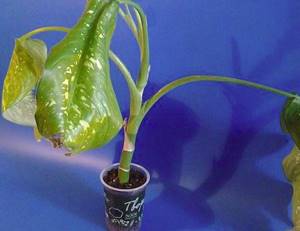
Root rot
Burgundy spots appear on the corm. The disease often develops in moist soil. Despite frequent watering, the calla lilies begin to fade.
Diseases of calla lilies
Garden callas most often suffer from such common diseases as wet rot and yellow spot.
Wet rot is a bacterial infection. Its signs:
- Rot of peduncles and leaves;
- Sluggish rotten roots;
- The presence of rotten brown spots on tubers.
The plant can be saved only at the onset of the disease during wintering or before planting in the ground. All diseased parts of the tuber are removed, and the sections are covered with a solution of brilliant green. If the disease appears in the summer, the diseased plant must be removed from the planting and destroyed.
Yellow spot is a viral disease . Its main manifestations:
- Leaf curl;
- Deformation of flowers;
- Light spots on the leaves.
Treatment methods for this disease have not been developed. For preventive purposes, thrips, the pests that carry it, are destroyed. Insecticidal preparations are used to combat thrips.
The most common pests that attack garden callas are aphids and spider mites. Timely treatment of plantings with Actellik or Fitoverm will help completely get rid of harmful insects.
What parasites are calla lilies susceptible to?
Beautiful calla lily flowers and their huge leaves are often attacked by insect pests. You can prevent the appearance of insects if, before planting, carefully dig up the soil, remove weeds and, for prevention, spray with biological insecticides.
Calla lily leaves are usually attacked by mites and aphids. Wireworms and thrips feed on tubers. Cabbage cutworm caterpillars eat huge holes in the leaves. If insects are detected, callas are sprayed with chemical insecticides (Commander, Iskra, Actellik).
Reproduction methods
Depending on the species, calla lilies reproduce in different ways. The most popular is propagation by tubers. Ready-made planting material can be bought in a store and immediately planted in a flowerbed at the beginning of summer.
Tubers
Tubers are dug up in the fall, before frost arrives. They are cleared of soil, washed with cold water and dried. The babies are separated from the mother tuber. Small and adult tubers are wrapped in paper and stored until spring at a temperature of 5-10 degrees Celsius. The next season they are planted individually in a flower bed or in April they are planted in pots for seedlings. Healthy tubers should have a firm texture. They will bloom the year they are planted.
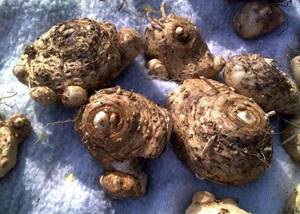
Dividing the bush
The Ethiopian calla lilies do not have tubers. It has a long rhizome. To propagate, you need to dig up an adult bush, break off young root shoots from the edge of the rhizome and place each one in a separate pot with soil. The procedure is carried out in the fall. All winter, the roots are stored in a cool, dark room, in a pot of soil, at a temperature of 5-10 degrees Celsius. In the spring, containers with rhizomes are brought into a warm room and watered. Soon the roots sprout. At the beginning of summer, grown seedlings can be planted in a flower bed.
How to grow callas (video)
These and other factors influence the ability of various types of calla lilies to adapt and survive in indoor growing conditions and in the garden. Among the most popular among flower growers are the following types:
| Species name | External description | Growing conditions |
| Ethiopian calla | A tall species with leaf petioles growing up to 1 m in length. The above-ground part is preserved even at rest; the underground part is a compact branched rhizome. Blooms predominantly white or green, depending on the variety | Loves partial shade and plenty of moisture in the soil and air. It tolerates temperature fluctuations well, but even with short-term cold snaps it can die. Ideal for decorating the coastal zone of garden ponds, looks good near fountains and other decorative ponds |
| Calla Remanna | The plant is of medium height with green leaves about 30 cm long. The flowers are small, red, pink or burgundy. The underground part is the tuber | Leaf growth begins in the spring; in winter, the plant sheds its leaves and goes to rest. Prefers dry places with diffused light. Looks good in group plantings with plants up to 50 cm high |
| Calla Eliotta | The species is represented by plants with variegated leaf blades and yellow-green inflorescences. The plant itself is low, the leaves are heart-shaped, the underground part is in the form of a tuber | They love bright places, but cannot tolerate prolonged heating in direct sunlight. The species is good in mass plantings with plants whose leaves are colored the same color. This species can be planted alone near garden sculptures and as a lower tier in shrubs with a sparse crown. |
In nature, there are also white-spotted, joyful, fragrant and powerful calla lilies. They, unfortunately, do not represent decorative value for Russian flower growers. But even among the three species that are successfully bred in middle and northern latitudes, there are surprisingly beautiful specimens that even the most experienced lover of these flowers will certainly want to grow at home. Breeders from Europe and Asia put a lot of effort into developing about a dozen varieties, the “parents” of which were the species mentioned above.

